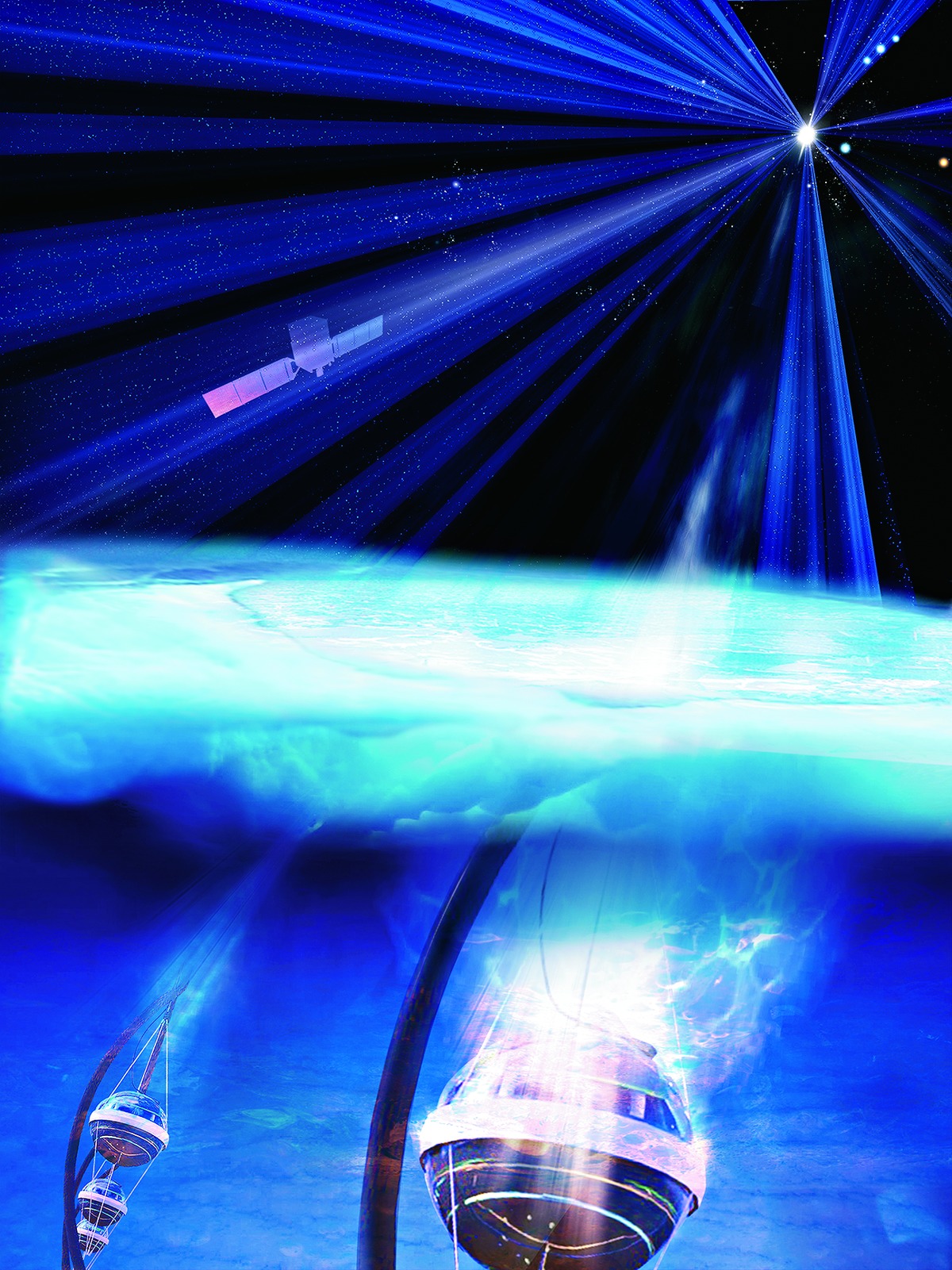
the source of a high-energy neutrino observed by the IceCube Neutrino Observatory
Do you know that billions of mysterious particles go through you every second? But don't worry, they cause no harm. Like ghosts, they can slip through matter.
These elusive particles are called neutrinos. There are lots of them in the universe. They have virtually no mass and travel almost as fast as light. Their biggest attraction for an astronomer is that - because they hardly ever interact with anything - they carry "clean" information from wherever they are born.
Everything we know about the universe has been learnt through light - radio waves, visible light, X-rays, very high-energy light called gamma rays. However, some of the most interesting places, such as the regions near black holes or the birthplaces of stars, are hidden behind dense clouds of dust and gas. Neutrino astronomy would allow us to pierce these veils and understand what's happening behind them.
But how does one detect a ghost? With enormous detectors that monitor a vast number of atoms. This increases the chances of catching a neutrino colliding with an atom. Neutrino detectors are built deep underground to screen out interfering particles called cosmic rays.
The latest in neutrino detectors is the IceCube. The largest telescope ever built, it is located below the South Pole and consists of one cubic kilometre of the cleanest ice in the world. A three dimensional array of detectors looks for telltale flashes of light when a neutrino collides with an atom, producing a muon that travels through the ice. By recording the sequence of flashes, the direction the neutrino came from can be calculated.
I first learnt about a telescope below the ice in 1997. At the time, I was working on a project at the South Pole. IceCube's predecessor, AMANDA, was then being built. All of us were fascinated by the construction, which involved drilling very deep holes in the ice with hot water - what else. Cables with detectors attached at regular intervals were then lowered and allowed to freeze in place. The hot water was of special interest to us. Scientists are allowed only two showers a week at the South Pole, so a lot of people took advantage of that extra hot water.
Teasing out the secrets of the universe is never easy. But the IceCube team announced in 2013 the detection of 28 extremely high-energy neutrinos. There was a firestorm of speculation about the origin of these and that is where we came in.
Matthias Kadler of the University of Wuerzburg, Germany, and I lead a team, called TANAMI, that regularly observes bright gamma-ray blazars in the far southern hemisphere. Blazars are galaxies like our Milky Way but they have a supermassive black hole at their centre. They rapidly change brightness and shoot out matter at near-light speed along two oppositely pointed jets. One of these jets is pointed towards Earth.
Kadler noticed that two of the IceCube neutrinos were from the same part of the sky as six TANAMI blazars. IceCube had dubbed these neutrinos "Bert" and "Ernie" after the lovable characters in the TV show, Sesame Street, which reminded scientists at the South Pole of their children back home. Using observations of these six TANAMI blazars at all light wavelengths, we were able to show that they could have given birth to Bert and Ernie. These calculations were led by then student Felicia Krauss, who is now at the University of Amsterdam, Netherlands.
In October 2012, my then-graduate student Michael Dutka (now at the US Naval Observatory) and I were watching the gamma-ray sky using the Fermi Gamma-ray Space Telescope when a blazar called PKS 1424-418 started to brighten dramatically. We alerted the astronomical community and other scientists started observing it at different wavelengths. This was an unusual flare-up with the gamma-ray brightness reaching about 28 times the blazar's typical brightness. We realised that another IceCube neutrino, BigBird, could be from the same part of the sky as this blazar.
Unfortunately, the origin of BigBird could not be pinpointed. But we found that there was only a five per cent chance that BigBird and PKS 1424-418 were not connected. It began to look plausible that high-energy neutrinos are born in blazars.
Then, in September 2017, IceCube announced the discovery of a very high-energy neutrino -IceCube-170922A. Unlike BigBird, the news of IceCube-170922A was public less than a minute after its discovery and its position in the sky was much better determined. Yasuyuki Tanaka, then at Hiroshima University in Japan, alerted our Fermi collaboration that they were seeing an optical flare from a blazar called TXS 0506+056 in the same location. Within minutes, I was able to confirm that there was a corresponding flare in radio waves and Italian Space Agency's Stefano Ciprini confirmed a flare-up in gamma-rays.
Dozens of telescopes observed TXS 0506+056. The chance that TXS 0506+056 is the birthplace of IceCube-170922A was calculated in many different ways and the consensus is that there is less than a 1-in-340 chance that this is a coincidence.
We might just have cracked the mystery of the birth of those ghost particles in the fast-moving jets of blazars. Scientists demand a very high standard of proof, and we do not have enough confirmation yet. We hope IceCube will make more detections. There are also new neutrino observatories being built and IceCube itself may be expanded to 10 times its current volume.
Who knows what more we will learn from our cosmic messengers, the neutrino?
The writer grew up in Darjeeling, where he developed a fascination for the sky and dalle khorsani , the hot Himalayan chilli. He works for the Fermi Gamma-ray Space Telescope at Nasa's Goddard Space Flight Center, US










